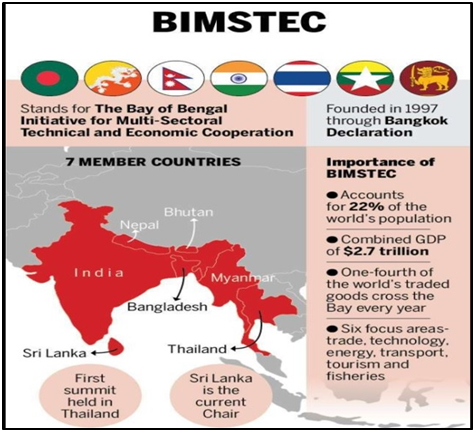Why in news?
The Bay of Bengal Initiative for Multi-Sectoral Technical and Economic Cooperation (BIMSTEC) can now accept new members and observers. This follows after the first charter of BIMSTEC came into force on May 20.
What’s in today’s article?
- BIMSTEC
- BIMSTEC charter comes into force
Bay of Bengal Initiative for Multi-Sectoral Technical and Economic Cooperation (BIMSTEC)
- About
- BIMSTEC It is an economic bloc that came into being in June 1997 through the Bangkok Declaration.
- BIMSTEC was initially formed with four member states- Bangladesh, India, Sri Lanka and Thailand on June 6, 1997.
- Nepal became an observer state in 1998 and became full-time member of the bloc along with Bhutan in February 2004.
- Members - Bangladesh, India, Myanmar, Sri Lanka, Thailand, Nepal and Bhutan.
- Permanent Secretariat - Dhaka, Bangladesh

- Aim
- Its aim is to counter the onslaught of globalisation by accelerating regional growth through mutual cooperation by utilising regional resources and geographical advantages.
- Areas of cooperation
- It is sector-driven cooperative organisation in which, initially, 6 sectors had been included:
- Trade, Technology, Energy, Transport, Tourism and Fisheries
- As of now, BIMSTEC has 14 priority areas of cooperation.
- Climate change was added as the 14th priority area of cooperation in 2008.
- Among these priority areas, a member country chooses which of the 14 priority areas it is willing to take lead.
- India is lead country for Transport & Communication, Tourism, Environment & Disaster Management, Counter-Terrorism & Transnational Crime.
- Importance of BIMSTEC
- Around 22% of the world’s population live in the seven countries around the Bay of Bengal, with a combined GDP close to $2.7 trillion.
- All seven countries have sustained average annual rates of growth between 3.4% and 7.5% from 2012 to 2016.
- A fourth of the world’s traded goods cross the bay every year.
- Growth of BIMSTEC as a regional forum
- The grouping had been largely ignored until India gave it a renewed push in October 2016, a month after the terrorist attack in Uri.
- Alongside the BRICS summit in Goa, India hosted an outreach summit with leaders of BIMSTEC countries.
- After the Uri attack, various countries had supported New Delhi’s call for a boycott of the South Asian Association of Regional Cooperation (SAARC) summit scheduled in Islamabad that November.
- Significance of BIMSTEC for all member countries
- Bangladesh views BIMSTEC as a platform to position itself as more than just a small state on the Bay of Bengal.
- Sri Lanka sees it as an opportunity to connect with Southeast Asia and serve as the subcontinent’s hub for the wider Indo-Pacific region.
- Nepal and Bhutan aim to connect with the Bay of Bengal region and escape their landlocked geographic positions.
- For Myanmar and Thailand, connecting more deeply with India would allow them to access a rising consumer market and, at the same time, balance Beijing and develop an alternative to China’s massive inroads into Southeast Asia.
- For India, the region’s largest economy, a lot is at stake. It is a natural platform to fulfil India’s key foreign policy priorities of Neighbourhood First and Act East.
- Challenges
- There is a growing discord between Bangladesh and Myanmar which has displaced more than a million Rohingya refugees who entered Bangladesh in 2017.
- Similar refugees from Myanmar have also streamed into Thailand ever since the February 2021 coup.
- BIMSTEC has become a new battleground in the India-China battle for dominance.
- China has undertaken a massive drive to finance and build infrastructure in South and Southeast Asia through the Belt and Road Initiative.
- It has done so in almost all BIMSTEC countries, except Bhutan and India.
BIMSTEC charter comes into force
- Background
- Following the pandemic, the leaders of the BIMSTEC nations met virtually on 30 March 2022 under the chairship of Sri Lanka and adopted the charter.
- BIMSTEC charter was adopted during its 5th Summit in March 2022.
- The chair of BIMSTEC was taken up by Thailand after the 5th leaders’ summit.
- Charter comes into force
- In April 2024, Nepal’s parliament took up the BIMSTEC charter and ratified it which paved the way for the coming into force of charter.
- As a result, BIMSTEC charter is said to have come into force on May 20, 2024.
- BIMSTEC has acquired a legal personality
- With the coming into force of the charter, the BIMSTEC has acquired a ‘legal personality’.
- Legal personality means that a person or entity has rights and duties in law.
- Now, it will be able to enter into structured diplomatic dialogue with other groupings and countries.
- The coming into force of the charter will provide legal and institutional framework for meaningful cooperation and deeper integration of the Bay of Bengal region.










